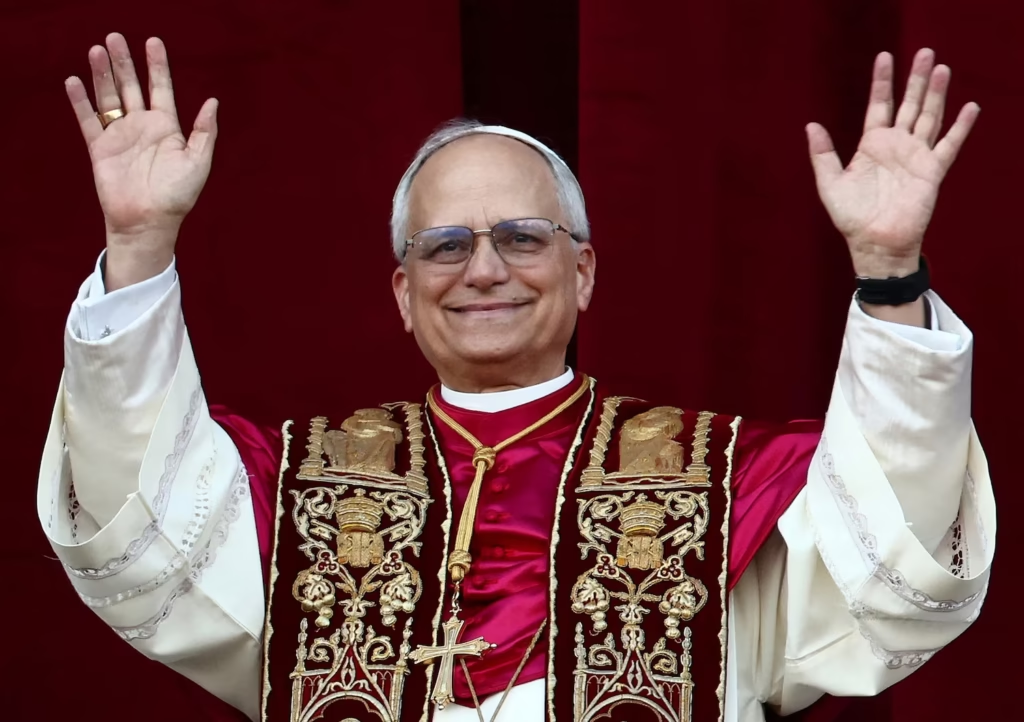On Thursday, the world witnessed a historic moment as a plume of white smoke emerged from the temporary chimney atop the Sistine Chapel, signaling the election of a new pope for the Catholic Church. The smoke, which is traditionally used to announce the election of a new pontiff, rose from the chapel in Rome, filling the air with anticipation. The smoke’s appearance marked the culmination of intense deliberations inside the chapel, where 133 cardinals from around the globe had gathered to vote on who would succeed Pope Francis, the beloved leader who had served the Church for many years.
The election of a new pope is one of the most significant events in the Catholic faith, and the announcement of the new leader of the Church was eagerly awaited by millions of Catholics and observers worldwide. As the white smoke billowed into the sky, the bells of St. Peter’s Basilica rang out in celebration, and a large crowd gathered in St. Peter’s Square to witness the momentous occasion. The excitement was palpable as people from all walks of life came together to honor the selection of a new spiritual leader for the global Catholic community.
Following the appearance of the white smoke, the Vatican confirmed the results of the conclave voting. The new pope, American Cardinal Robert Prevost, was announced as the choice to replace Pope Francis, who had led the Church for nearly a decade. Cardinal Prevost’s election comes amid the third round of conclave voting, a sign of the cardinals’ consensus on his ability to lead the Church into a new chapter.
The election of Cardinal Prevost marks a historic moment for the Catholic Church, as it is the first time an American cardinal has been chosen to serve as pope. His selection is seen as a reflection of the global nature of the Church and the changing dynamics within the Vatican. Cardinal Prevost, a seasoned cleric with years of experience serving the Church, is widely regarded as a man of deep faith, integrity, and commitment to the teachings of the Catholic faith.
Prevost’s rise to the papacy has been closely watched, especially given the challenges the Catholic Church has faced in recent years. Under Pope Francis, the Church underwent significant reforms and focused on issues such as poverty, climate change, and interfaith dialogue. These efforts, while transformative, have not been without controversy, and many were eager to see what direction the new pope would take in addressing these ongoing challenges. Cardinal Prevost, with his American background and years of service in various parts of the world, is expected to bring a fresh perspective to the papacy, one that is deeply rooted in the values of compassion, justice, and spiritual growth.
As the announcement of Cardinal Prevost’s election was made, the crowd in St. Peter’s Square erupted in cheers and applause, celebrating the beginning of a new era for the Catholic Church. The sense of unity and joy among the faithful was palpable, as people from all corners of the globe gathered to witness this historic moment. The selection of a new pope is always a time of great significance, not only for the Catholic Church but for the broader global community. The pope is not just a religious leader; he is also a symbol of hope, peace, and moral guidance for millions of people worldwide.
Cardinal Prevost’s election comes after a period of uncertainty within the Vatican, following Pope Francis’ decision to step down due to health concerns. Pope Francis, who had been a beloved figure for his progressive views and emphasis on social justice, made history by becoming the first pope in nearly 600 years to resign from the papacy. His decision to step down created a moment of transition for the Church, and the conclave was called to select a new leader who could continue his work while navigating the complexities of modern-day Catholicism.
The conclave, which is held in the Sistine Chapel, is a highly secretive process where cardinals gather to vote for the new pope. To be elected, a candidate must receive a two-thirds majority vote from the cardinals. The process is steeped in tradition and ritual, with the cardinals participating in multiple rounds of voting until a new pope is chosen. The white smoke that signals the conclusion of the election is a powerful symbol of the unity and decision-making of the cardinals, who are tasked with selecting the leader of the world’s largest Christian denomination.
For the Catholic Church, the election of a new pope is a time of reflection and renewal. It offers an opportunity to consider the future direction of the Church, the challenges it faces, and the spiritual guidance it provides to billions of followers. Cardinal Prevost’s election will undoubtedly lead to discussions about the role of the Church in today’s world, the continuing challenges it faces in terms of transparency and accountability, and the ways in which it can continue to spread the message of faith, hope, and love to those who need it most.
As Pope Francis’ papacy came to a close, the expectations for the next leader of the Church were high. Many hoped that the new pope would continue to champion the progressive values that Pope Francis had emphasized, such as social justice, environmental stewardship, and a focus on the marginalized and impoverished. Others hoped for a return to more traditional values and a stronger emphasis on doctrinal purity. Whatever direction Cardinal Prevost chooses to take, his leadership will shape the Catholic Church for years to come, and his influence will be felt in communities around the world.
In the days and weeks following the announcement of Cardinal Prevost’s election, attention will inevitably turn to his plans for the future of the Church. What reforms will he pursue? How will he address the ongoing challenges within the Vatican? What role will the Catholic Church play in addressing global issues such as climate change, inequality, and political polarization? These questions, among many others, will shape the legacy of the new pope as he takes on the immense responsibility of leading one of the world’s most influential religious institutions.
As the faithful around the world reflect on the election of Cardinal Prevost, they are reminded of the deep spiritual and moral guidance that the papacy provides. The pope is not just a political figure or a leader of an institution; he is a spiritual shepherd who offers hope, guidance, and comfort to millions of people. In the midst of a rapidly changing world, the election of a new pope is a reminder of the enduring power of faith and the role of the Church in providing moral and spiritual leadership.
The selection of Cardinal Robert Prevost as the new pope marks the beginning of a new chapter for the Catholic Church, one that is filled with both promise and challenge. As the world watches closely, the new pope’s actions will be scrutinized, celebrated, and critiqued. But for now, the faithful can celebrate this momentous occasion, knowing that the Church has a new leader who will carry on the mission of spreading love, peace, and faith to all corners of the world.
With Cardinal Prevost’s election, the Catholic Church enters a new era, one that will be defined by his leadership and the direction he chooses for the future of the faith. For millions of Catholics, the election of a new pope is not just a political event—it is a moment of profound spiritual significance, a reminder of the power of faith to bring people together and guide them toward a better future.


